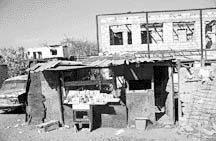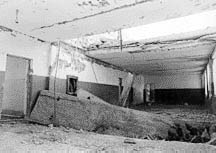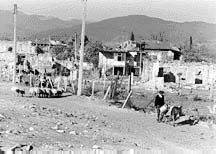|
Winter 1996 (4.4)
Horadiz
President Aliyev is pushing for the reconstruction process to begin immediately. On July 12, 1996, he signed a decree to organize a State Commission for the Restoration and Reconstruction of lands destroyed and damaged by the Armenian military occupation, and appointed Abid Sharifov to head this Commission. Sharifov is the Deputy Prime Minister and Chairman of the State Committee for Construction and Architecture. He also is one of the most experienced contractors in the country, having built some of Baku's most prominent buildings of the 1970s and 80s including the Azerbaijan and Absheron hotels, the Presidential Guest House and the United Nations Building. In the international community, the driving force behind reconstruction is UN Representative Paolo Lembo. It was Lembo who carried the UN flag in his suitcase to establish the mission in Baku in 1992. Over the years, he has developed a great sympathy for the Azerbaijani people and for the potential for development in this country and the region. Lembo has taken it upon himself to convince international entities-both lending agencies as well as foreign governments-of the appropriateness of starting the reconstruction project now. But it's a controversial topic. International financial institutions rarely provide funds for such projects until both countries have signed a peace accord. As yet, Armenia and Azerbaijan have no such contract, although a cease-fire has been in effect since May 1994. Many funding agencies have argued that it's too early to start reconstruction, pointing to the example of Bosnia where peace was signed before reconstruction began. They're afraid that shelling could resume and everything could be destroyed all over again. But Lembo doesn't think there will be any more fighting. Too much is at stake for both sides. To illustrate the potential outcome of starting reconstruction, Lembo points to the example of the Gaza Strip, a disputed piece of land between the Palestinians and Israelis. In this situation, the European Union pledged funds for reconstruction prior to a peace treaty. The promise of funds seemed to have encouraged and accelerated the negotiation process. "Often when both sides realize that there is money for reconstruction, there is a greater incentive to bring hostilities to a conclusion," Lembo observed. "That's exactly what we'd like to see happen between Azerbaijan and Armenia." By October, Lembo had secured $1.5 million from the UNDP (United Nations Development Program) and $1.3 million from the World Bank. The master plan for reconstruction covers seven regions of Azerbaijan's territory that have been military occupied. During these last few months, the European community and Americans have become more convinced of the validity of this approach. To draw attention to the reconstruction issue, Lembo arranged for the United Nations to celebrate their 52nd Anniversary (October 24) in Horadiz, and invited representatives from the government, as well as the international community, to make the trip by helicopter or drive four hours to the little town. In the meantime, there's one
train a day with two passenger cars that has been taking the
refugees back to their community. "In many of these regions,
the things that weren't bombed or burned have been looted, sometimes
right down to the foundations of the buildings," says an
observer who visited the region. It's going to be a big job-reconstruction
will run into the billions. But, at least, it's getting started. AI Home | Magazine Choice | Topics | Store | Contact us |



 Azerbaijan's
President Aliyev has always insisted upon the complete withdrawal
of Armenian military personnel from Azerbaijan's territory as
a prerequisite for peace. And the international community supports
him.
Azerbaijan's
President Aliyev has always insisted upon the complete withdrawal
of Armenian military personnel from Azerbaijan's territory as
a prerequisite for peace. And the international community supports
him.